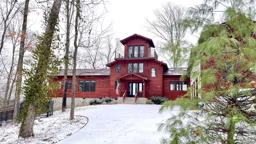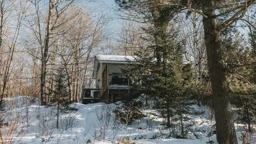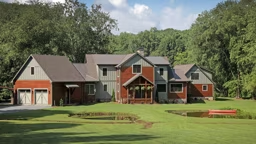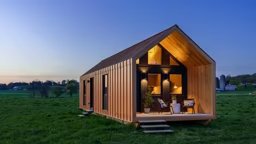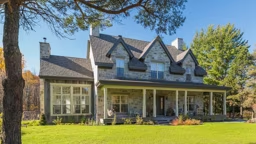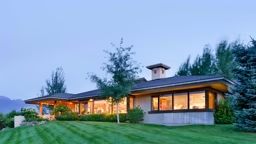Call it a common occupational hazard.
Jeff Grundahl is the president of a homebuilding and remodeling company, so when he and his wife, Mary, bought a little 50s “vinyl box” of a cabin, you might have expected a crew there the next day. Not exactly.
When you’re a builder or remodeler, your clients’ projects come first. So while it may have taken a few years to get renovations rolling, the Grundahls will tell you the transformation was worth the wait.
Getting Rolling
During the long Midwestern winters, Jeff and Mary talked about ways to make their little rambler-style vacation home more useable. It had two bedrooms, a kitchen/dining room and a little-used open porch crammed on the main floor – plus a strictly utilitarian basement. (That’s code for a gloomy spot to store wetsuits and water skis, throw in a load of laundry and run right back up.)
“When it came to fixing [the cabin] up,” says Jeff, “the discussion started at one level and finished at another.” What he means is that even remodeling professionals fall prey to upsizing a project (another occupational hazard). Jeff explains, “It originally started with ‘Let’s just finish the lower level so it is usable, and redo the siding’… Well, you can see how that turned out.”
The renovation has been so complete, the original lakehome may as well have joined the Witness Protection Program; it’s that unrecognizable.
Jeff Grundahl is the president of a homebuilding and remodeling company, so when he and his wife, Mary, bought a little 50s “vinyl box” of a cabin, you might have expected a crew there the next day. Not exactly.
When you’re a builder or remodeler, your clients’ projects come first. So while it may have taken a few years to get renovations rolling, the Grundahls will tell you the transformation was worth the wait.
Getting Rolling
During the long Midwestern winters, Jeff and Mary talked about ways to make their little rambler-style vacation home more useable. It had two bedrooms, a kitchen/dining room and a little-used open porch crammed on the main floor – plus a strictly utilitarian basement. (That’s code for a gloomy spot to store wetsuits and water skis, throw in a load of laundry and run right back up.)
“When it came to fixing [the cabin] up,” says Jeff, “the discussion started at one level and finished at another.” What he means is that even remodeling professionals fall prey to upsizing a project (another occupational hazard). Jeff explains, “It originally started with ‘Let’s just finish the lower level so it is usable, and redo the siding’… Well, you can see how that turned out.”
The renovation has been so complete, the original lakehome may as well have joined the Witness Protection Program; it’s that unrecognizable.
A Better Use of Space
You may have heard the expression: “You can’t make an omelet without breaking a few eggs.” Or in this case ... ripping down every wall to the studs.
This was the best way for the Grundahls to revamp the entire layout to get the more open floor plan they wanted. Post-renovation, those two small bed-rooms are now three far more spacious ones, and there’s a bigger bath now that the kitchen and dining room have been relocated on the walkout level.
And that sad, unloved sun porch? It’s now the beloved master bedroom. “We now have four windows that face the lake, it’s a really great view – and we took a room that was never used, and now it’s used everyday,” says Jeff.
Another matter was making the stairs leading to the lower level more accessible. “I used to have to duck my head, and I’m a relatively short guy,” says Jeff, who sacrificed a closet and added a two-foot bump out for a higher clearance.
An added window sheds light on the stairwell, which has railing balusters custom-made on site using mountain ivy twigs. This is one of Jeff’s favorite details. He says, “It’s a great way to bring some nature inside.”
You may have heard the expression: “You can’t make an omelet without breaking a few eggs.” Or in this case ... ripping down every wall to the studs.
This was the best way for the Grundahls to revamp the entire layout to get the more open floor plan they wanted. Post-renovation, those two small bed-rooms are now three far more spacious ones, and there’s a bigger bath now that the kitchen and dining room have been relocated on the walkout level.
And that sad, unloved sun porch? It’s now the beloved master bedroom. “We now have four windows that face the lake, it’s a really great view – and we took a room that was never used, and now it’s used everyday,” says Jeff.
Another matter was making the stairs leading to the lower level more accessible. “I used to have to duck my head, and I’m a relatively short guy,” says Jeff, who sacrificed a closet and added a two-foot bump out for a higher clearance.
An added window sheds light on the stairwell, which has railing balusters custom-made on site using mountain ivy twigs. This is one of Jeff’s favorite details. He says, “It’s a great way to bring some nature inside.”
Moving the Party Downstairs
Because entertaining and access to the outdoors are a big part of cabin life to the Grundahls, the decision was made to move the entire party downstairs to the walkout lower level, “We are always lakeside. Now the whole lower level is a kitchen and casual dining area,” says Jeff of the open space with a freestanding bar and peninsula with seating. “There’s no dining room table, it’s this little nook where we can seat 10, 11 people,” he explained. Whether the deck’s gas grill is serving up Jeff’s own elk from Wyoming hunting trips or mahi-mahi with mango salsa, another crowd favorite, the family is thrilled to no longer be running upstairs for forgotten kitchen items.
The couple chose hardworking surfaces for this busy area. The countertops are a tough engineered quartz product coupled with manufactured alder cabinets. “That floor is not wood, it’s a true vinyl floor laid in solid planks … they tell me it may well outlast me,” laughs Jeff.
Because entertaining and access to the outdoors are a big part of cabin life to the Grundahls, the decision was made to move the entire party downstairs to the walkout lower level, “We are always lakeside. Now the whole lower level is a kitchen and casual dining area,” says Jeff of the open space with a freestanding bar and peninsula with seating. “There’s no dining room table, it’s this little nook where we can seat 10, 11 people,” he explained. Whether the deck’s gas grill is serving up Jeff’s own elk from Wyoming hunting trips or mahi-mahi with mango salsa, another crowd favorite, the family is thrilled to no longer be running upstairs for forgotten kitchen items.
The couple chose hardworking surfaces for this busy area. The countertops are a tough engineered quartz product coupled with manufactured alder cabinets. “That floor is not wood, it’s a true vinyl floor laid in solid planks … they tell me it may well outlast me,” laughs Jeff.
Inspired Exterior: Mountain Architecture
Jeff admired a vacation place in Utah he saw that incorporated a look he calls “mountain architecture.” He explains, “It’s not just limited to log or timber frame, it’s a hybrid that blends the materials with the surroundings.” Given the family’s affinity to the Western states, this “elevated rustic look” fits them perfectly.
Using as many recycled and renewable products as possible, the design combined different materials, varying the textures and color with splashes of bright red with green trimmed windows – including energy-efficient bow windows with a bumped-out profile.
Starting with the stone foundation, applied as a thin-cut veneer shipped from a Montana stone supply company, they worked their way up to the wood exterior, mixing reclaimed barn board with hand-split cedar shakes offset with bands of cedar board. Lastly, hand-hewn log siding distinguishes the new master bedroom.
Heavy outside corner posts from hand-hewn fir give a rustic feel to the project, balanced with modern accents like stainless cable along the porch railings. “These are great for not obstructing sightlines from inside. Now the view out the front is fantastic,” says Jeff.
Nothing changes the feel of a structure like a roofline. The cabin now has an added gabled roof with Boston ridges (think mini-roofs along the roof ridge) for added ventilation and a notable design feature. Other elements like shed roofs (little awnings over the doorways that keep the entrance dry) also add flair to what was once a boxy exterior.
We did a few things that were purely architectural,” admits Jeff. “Like the clerestory windows, which look great from the lake, but don’t actually go anywhere,” says Jeff.
Jeff admired a vacation place in Utah he saw that incorporated a look he calls “mountain architecture.” He explains, “It’s not just limited to log or timber frame, it’s a hybrid that blends the materials with the surroundings.” Given the family’s affinity to the Western states, this “elevated rustic look” fits them perfectly.
Using as many recycled and renewable products as possible, the design combined different materials, varying the textures and color with splashes of bright red with green trimmed windows – including energy-efficient bow windows with a bumped-out profile.
Starting with the stone foundation, applied as a thin-cut veneer shipped from a Montana stone supply company, they worked their way up to the wood exterior, mixing reclaimed barn board with hand-split cedar shakes offset with bands of cedar board. Lastly, hand-hewn log siding distinguishes the new master bedroom.
Heavy outside corner posts from hand-hewn fir give a rustic feel to the project, balanced with modern accents like stainless cable along the porch railings. “These are great for not obstructing sightlines from inside. Now the view out the front is fantastic,” says Jeff.
Nothing changes the feel of a structure like a roofline. The cabin now has an added gabled roof with Boston ridges (think mini-roofs along the roof ridge) for added ventilation and a notable design feature. Other elements like shed roofs (little awnings over the doorways that keep the entrance dry) also add flair to what was once a boxy exterior.
We did a few things that were purely architectural,” admits Jeff. “Like the clerestory windows, which look great from the lake, but don’t actually go anywhere,” says Jeff.
A Winning Remodel
In addition to winning building industry awards for the best remodel, Jeff believes the project got so much attention because it didn’t significantly alter the original footprint of the place. “With only a few bump outs, we changed the entire feel,” says Jeff.
And that feel has made it so his family spends more time at the cabin. “We’re there two to three times a week in the summer,” says Jeff. “The remodel has made it very hard to leave.”
Lucie Amundsen writes about eclectic vacation homes from her home near the shores of Lake Superior.
READER RESOURCE: JG Development, Inc., www.jgdevelopment.com.
See floor plan below
In addition to winning building industry awards for the best remodel, Jeff believes the project got so much attention because it didn’t significantly alter the original footprint of the place. “With only a few bump outs, we changed the entire feel,” says Jeff.
And that feel has made it so his family spends more time at the cabin. “We’re there two to three times a week in the summer,” says Jeff. “The remodel has made it very hard to leave.”
Lucie Amundsen writes about eclectic vacation homes from her home near the shores of Lake Superior.
READER RESOURCE: JG Development, Inc., www.jgdevelopment.com.
See floor plan below











